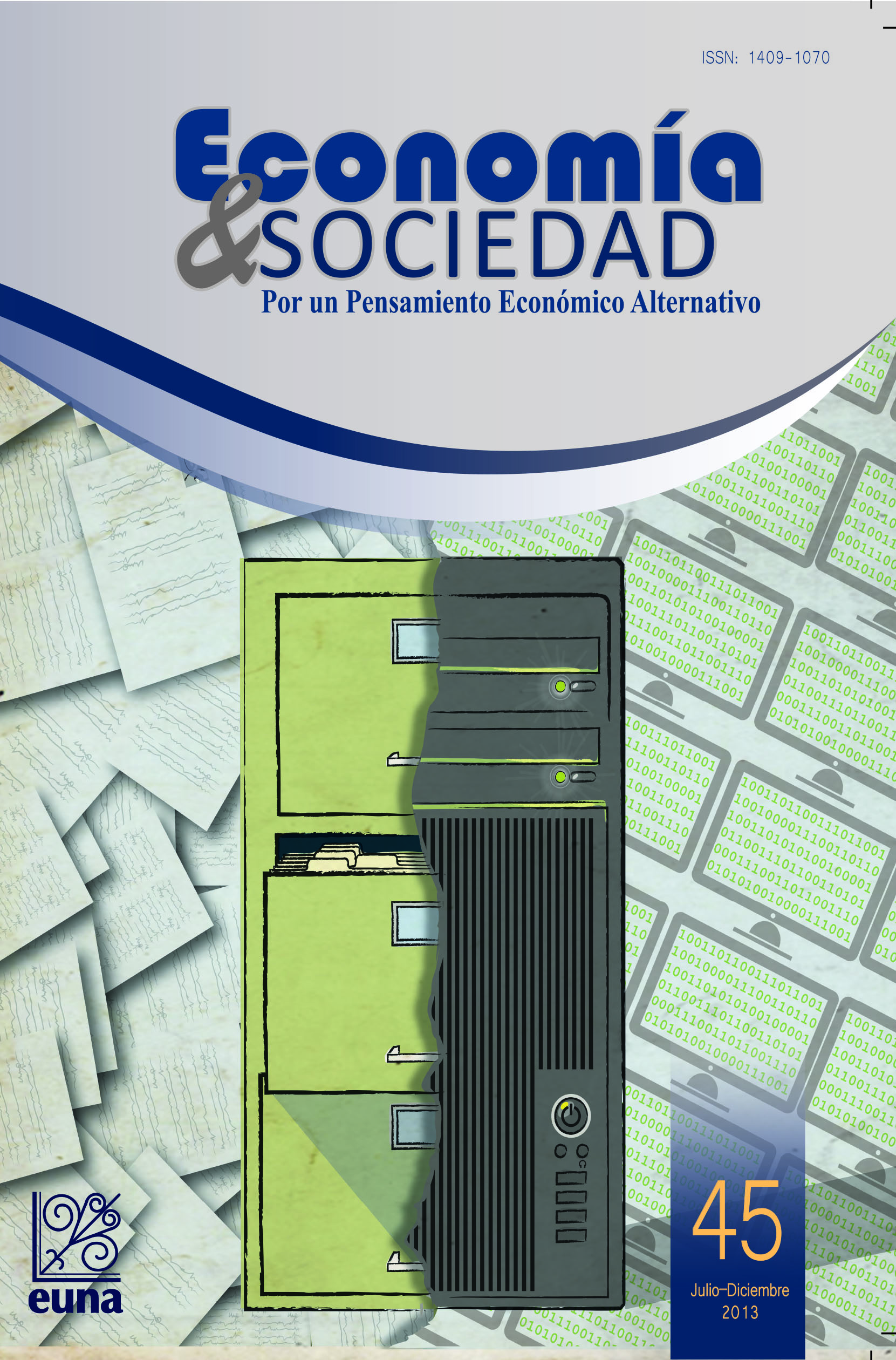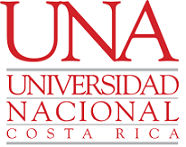Sostenibilidad fiscal en Costa Rica, 1991-2013: una aproximación a través del Método Montecarlo
DOI:
https://doi.org/10.15359/eys.19-45.3Palavras-chave:
Simulación, Método Montecarlo, sostenibilidad fiscalResumo
El presente documento es una aplicación de un modelo de sostenibilidad fiscal para la economía de Costa Rica. Se utiliza la metodología de límite natural de deuda propuesta por Mendoza y Oviedo (2009) y Simulaciones Montecarlo para calcular la probabilidad de superar este límite. El modelo presentado es una simplificación del aplicado por Tanner y Samake (2007) y Fernández (2005). Pronosticando 3 años se obtiene un 76,09% de probabilidad de superar el límite de deuda definido como crítico, lo que indica que la economía posee un alto riesgo de insostenibilidad de la deuda. Es por ello que basado en funciones de impulso respuesta se concluye el posible resultado de una política fiscal contractiva.
Referências
Acevedo, C. (2001). ¿Es sostenible la política fiscal en el Salvador? FUSADES. Recuperado de:http://www.fusades.org/index.php?option=com_jdownloads&Itemid=95&view=finish&cid=213&catid=36&lang=es
Blanchard, O. (1990). Suggestions for a new set of fiscal indicators. OECD working paper n. 79. Recuperado de: http://www.oecd.org/tax/public-finance/2002735.pdf
Buiter, W. (November, 1985). A Guide to Public Sector Debt and Deficits. Economic Policy, 21. doi: http://dx.doi.org/10.2307/1344612
De Gregorio, J. (2007). Macroeconomía: Teoría y políticas. México: Pearson Education. Recuperado de: http://www.degregorio.cl/
Dhrymes, P. (1970). Econometrics. Statistical foundations and aplications. Berlin: Springer-Verlag. Recuperado de: http://www.springer.com/statistics/book/978-0-387-90095-7
Fernández, K. (2005). Evaluación de la Sostenibilidad Fiscal en Costa Rica: Un Enfoque Estocástico. (Tesis de maestría). Pontificia Universidad Católica de Chile, Chile. Recuperado de: http://www.economia.puc.cl/docs/tesis_kfernandez.pdf
Ghysels, E. (1990). Unit-Root Tests and the Statistical Pitfalls of Seasonal Adjustment: The Case of U.S. PostwarReal Gross National Product. Journal of Business & Economic Statistics, 8(2) , 145-152. doi:http://dx.doi.org/10.1080/07350015.1990.10509785
Ghysels, E., & Perron , P. (1993). The Effect of Seasonal Adjustment Filters on Tests for a Unit Root.Journal of Econometrics, 55(1-2), 57-98. doi: http://dx.doi.org/10.1016/0304-4076(93)90004-0
Hamilton, J. (1994). Time series analysis. United States of America: Princeton University. Recuperado de:http://press.princeton.edu/titles/5386.html
Hansen, L. P., & Sargent, T. J. (January-February, 1993). Seasonality and aproximation errors in rational expectation models. Journal of Econometrics, 55(1-2), 21-55. doi: http://dx.doi.org/10.1016/0304-4076(93)90003-N
Keynes, J. M. (1971). Breve tratado sobre la reforma monetaria. México: Fondo de Cultura Económica. Recuperado de: http://www.fondodeculturaeconomica.com/librerias/Detalle.aspx?ctit=001604R
Méndez, E., & Durán, R. (1995). Orientación discrecional y cíclica de la política fiscal en Costa Rica. Recuperado de: http://www.bccr.fi.cr/investigacioneseconomicas/sectorpublico/Orientacion_Discrecional_Ciclica_Politica_Fiscal_en_Costa_Rica.pdf
Mendoza, E., & Oviedo, M. (July, 2004). Public debt, fiscal solvency and macroeconomic uncertainty in Latin America: The cases of Brazil, Colombia, Costa Ricam and Mexico. Recuperado de: http://www.nber.org/papers/w10637
Papadopoulos, A. P. y Sidiropoulos, M. G. (August, 1999). The Sustainability of Fiscal Policies in the European Union. International Advances in Economic Research, 5(3). doi: http://dx.doi.org/10.1007/BF02296413
Ross, S. (1999). Simulación. Mexico: Prentice Hall.
Segura, C., & Vásquez, J. P. (2011). Estimación del parámetro de suavizamiento del filtro de Hodrick y Prescott para Costa Rica. Recuperado de: http://www.bccr.fi.cr/investigacioneseconomicas/metodoscuantitativos/Estimacion_del_parametro_de_suavizamiento_del_filtro_de_Hodrick_y_Prescott_para_CR.pdf
Tanner, E., & Samake., I. (2007). Sostenibilidad probabilística de la deuda pública: Un enfoque de vectores autorregresivos para los casos de Brasil, México y Turquía. Recuperado de: http://www.captac-dr.org/c/document_library/get_file?folderId=107574&name=DLFE-4858.pdf
Talvi, E. & Végh, C., (1998). Fiscal Policy Sustainability: A Basic Framework. Recuperado de:http://idbdocs.iadb.org/wsdocs/getdocument.aspx?docnum=787999
Downloads
Publicado
Como Citar
Edição
Seção
Licença
This publication is subject to the Creative Commons License; therefore, its attributions and restrictions must be respected.
Authors publishing in this Journal accept the following conditions:
- Authors retain copyright ownership and give the Journal first publication right of the paper, which is registered with the Creative Commons Attribution-NonCommercial-ShareAlike 4.0 International License. This license allows third parties to use the published work provided it is sourced as firstly published in this Journal.
- Authors may enter into other independent and additional contractual agreements for the non-exclusive distribution of the article published in this Journal (e.g., to be included in an institutional repository or published in a book) provided it is clearly stated that the work was published in this Journal for the first time.
- Authors are allowed and recommended to publish their work on the Internet (for example, on institutional or personal pages) before and during the review and publication process, as it can lead to productive exchanges and a greater and faster dissemination of work published.

The Economía & Sociedad Journal, published by Universidad Nacional, is licensed under a Creative Commons Reconocimiento-NoComercial-CompartirIgual 4.0 Internacional License. Based on http://www.revistas.una.ac.cr/index.php/economia.








